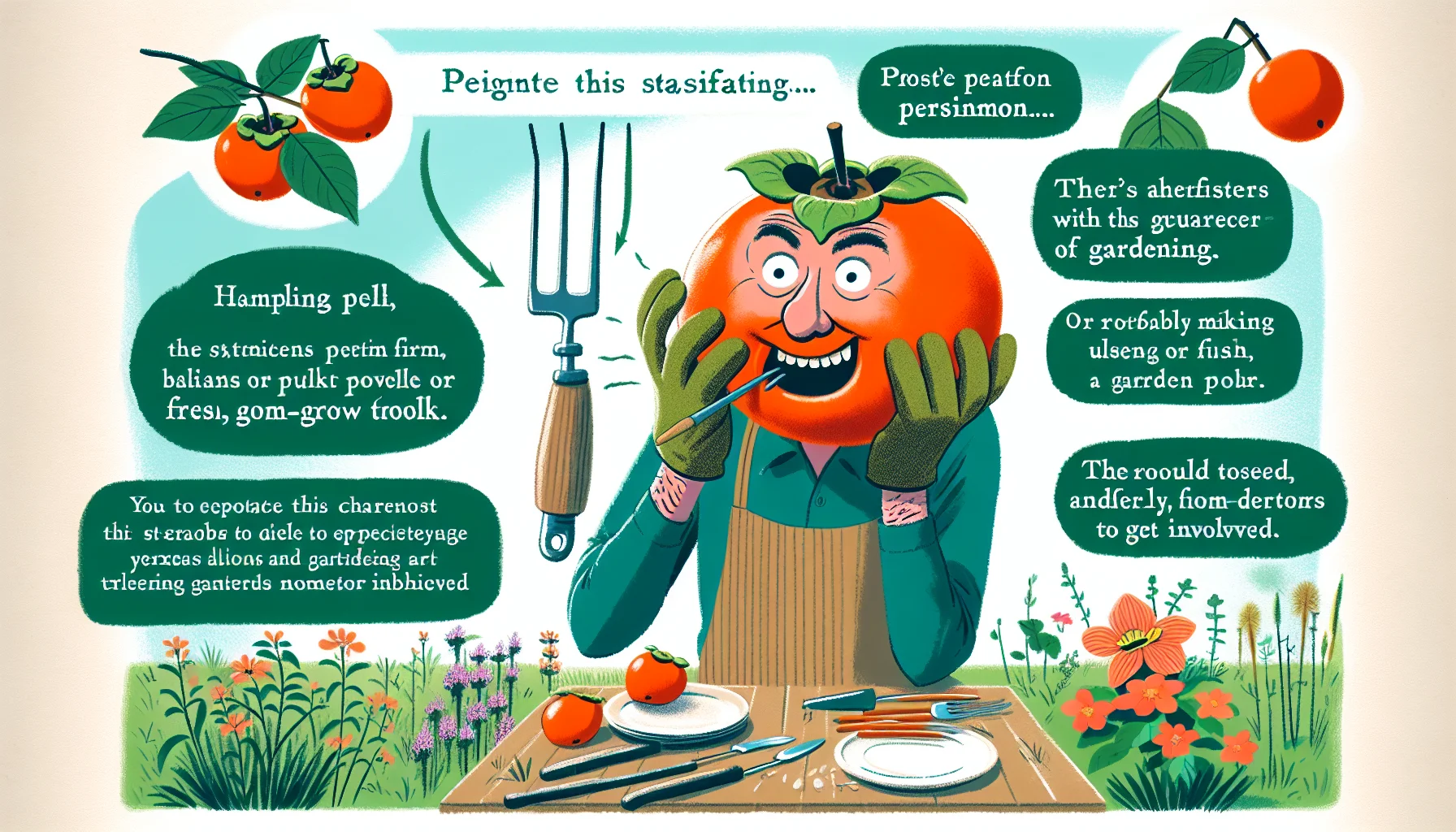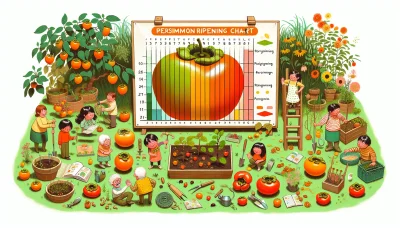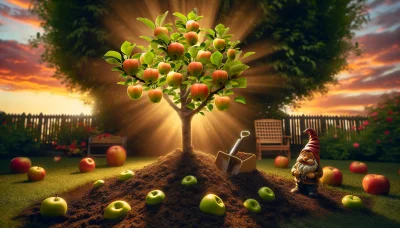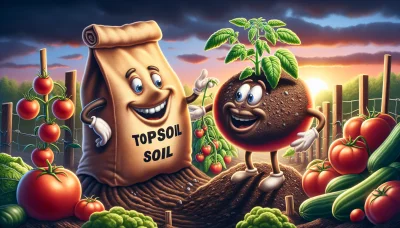How do you eat a persimmon Quiz
Test Your Knowledge
Question of
How Do You Eat a Persimmon?
Eating persimmons is a delightful experience that many gardening enthusiasts look forward to each year. These unique fruits, with their sweet, honey-like flavor, are not only delicious but also packed with nutrients. Understanding the right way to eat a persimmon can enhance your enjoyment of this fruit and potentially inspire you to incorporate it into your own garden. Whether you're curious about the different varieties, such as Fuyu or Hachiya, or seeking the best methods to prepare them, this guide will provide valuable insights into enjoying persimmons to the fullest.
Types of Persimmons
- Fuyu (Jiro) - Non-astringent and can be eaten while still firm. They are sweet and crisp, resembling tomatoes in shape.
- Hachiya - Astringent until fully ripe and soft. Known for their acorn shape, they have a rich, jelly-like texture when ripe.
- American Persimmon (Diospyros virginiana) - Native to the eastern United States, these are smaller and can vary in sweetness. They must be fully ripe before eating to avoid astringency.
- Tanenashi - A heart-shaped, astringent variety that is popular for its rich flavor and smooth texture when fully ripe.
- Chocolate Persimmon - Features a brownish flesh that is sweet and slightly nutty in flavor. It's astringent and needs to be fully ripe to enjoy.
- Maru (Cinnamon) - Known for its spicy flavor, it is round and squat in shape. Best eaten when soft, it has a unique cinnamon taste.
Preparing Persimmons for Eating
To properly prepare a persimmon for eating, start by selecting a fruit that has a deep orange color and a soft texture, indicating ripeness. If the persimmon feels hard, let it ripen at room temperature until it softens. Wash the fruit under cool running water before eating. You can eat the skin, but if you prefer it peeled, gently remove the skin with a paring knife. Persimmons can be cut into slices or wedges, depending on your preference. Be cautious of the variety; astringent types like Hachiya should be very soft before eating, while non-astringent types like Fuyu can be eaten while still slightly firm. Enjoy your persimmon as a healthy snack, or add it to salads and desserts for a sweet, unique flavor.
Creative Ways to Enjoy Persimmons
- Blend persimmons into smoothies for a sweet, nutritious treat.
- Add sliced persimmons to salads for a refreshing crunch.
- Bake persimmons into breads and muffins for a moist, flavorful addition.
- Make a persimmon chutney to complement cheeses or meats.
- Use persimmons in jams or preserves to capture their unique taste year-round.
- Create a persimmon salsa for a sweet and spicy dip or condiment.
- Roast persimmons with honey and spices for a simple yet delicious dessert.
- Include persimmons in your morning oatmeal or cereal for a sweet start to your day.
- Freeze persimmon slices and enjoy them as a cool, healthy snack.
- Experiment with persimmons in savory dishes, like stews or curries, to add a touch of sweetness.
Growing Your Own Persimmons
Persimmons are a delightful fruit to grow in the garden, offering both ornamental beauty and delicious harvests. To start, choose a sunny spot with well-draining soil. Planting grafted trees in early spring gives them the best start. Persimmons don't require much fertilizer, but they do need consistent watering, especially during dry spells, to develop their deep roots and support fruit production. As the trees mature, pruning in winter helps maintain shape and encourage healthy growth. Harvesting usually takes place in late fall, when the fruits have fully colored but before the first frost. With a little patience and care, your persimmon trees will reward you with bountiful crops for years to come.
Common Questions About Eating Persimmons
-
What are the nutritional benefits of eating persimmons?
Persimmons are rich in vitamins A and C, which are essential for immune function, vision, and skin health. They also contain manganese and fiber, which can aid in digestion and maintain a healthy metabolism. -
Can eating persimmons help with weight loss?
Yes, due to their high fiber content, persimmons can help you feel full for longer periods, potentially aiding in weight loss. They are also low in calories, making them a healthy addition to a weight loss diet. -
Are there any types of persimmons, and how do they differ?
There are two main types of persimmons: the Hachiya and the Fuyu. Hachiya persimmons are acorn-shaped and should be eaten when very ripe to avoid astringency, while Fuyu persimmons are squat, resemble tomatoes, and can be eaten while still a bit firm. -
How do you know when a persimmon is ripe and ready to eat?
For Hachiya persimmons, they should be very soft to the touch. Fuyu persimmons, on the other hand, can be enjoyed even when they are slightly firm, but they are sweetest when fully ripe. -
Can persimmons be eaten with the skin on?
Yes, the skin of persimmons is edible, but it's a matter of personal preference. Some people prefer to peel them because the skin can be a bit tough, especially on the Hachiya variety when not fully ripe. -
Are there any precautions to consider when eating persimmons?
Eating persimmons in moderation is generally safe for most people. However, due to their high fiber content, eating too many can lead to digestive issues such as bloating and gas. Additionally, unripe Hachiya persimmons contain tannins that can be astringent and unpleasant to eat.
Conclusion: The Joy of Eating Home-Grown Persimmons
Growing your own persimmons is a rewarding experience that offers numerous pleasures and benefits. From the joy of watching your trees bloom and bear fruit, to the satisfaction of harvesting and consuming your own produce, the process is deeply fulfilling. Home-grown persimmons are not only fresher and tastier than those bought from stores, but they also allow you to control the growing conditions, ensuring your fruit is free from harmful chemicals. Moreover, gardening, in general, is a therapeutic activity that can improve your physical and mental well-being. Encountering the sweet and rich flavors of your own persimmons is a unique pleasure that store-bought fruit simply cannot match. We encourage everyone to try growing their own persimmons and experience the unmatched joy it brings.












